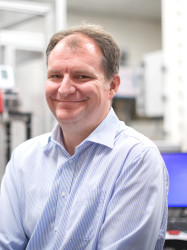Summary
Research Interests
My main research interest are in the modelling and simulation of multi-phase flow. My main applications are in minerals processing and, in particular froth flotation and heap leaching. My research forms part of the Rio Tinto Centre for Advanced Mineral Processing.
Heap Leaching
A major area of my research is heap leaching My particular interest is in the fluid flow and mass transport through the heaps. This involves multi-scale modelling and simulation. In particular, I use Smooth Particle Hydrodynamics to study the particle scale flow (see below) and mass transport behaviour and Finite Element/Finite Volume methods to model the behaviour at the heap scale.
Froth Flotation
One of my other main research focuses is on the behaviour of foams and froths, with particular application to the modelling of Flotation Cells, which are widely used as a separation technology in the Minerals Industry. We carry out both fundamental level studies on various aspects of foam behaviour, as well as experimental and modelling studies of industrial foams and froths. We have not only developed mathematical models of foams, but also a variety of experimental techniques to test the model predictions, including image analysis and tomographic methods. The main application of the research is the study of the froth phase of mineral flotation cells, but the fundamental nature of the approach has allowed us to model, amongst other things, food foams, foams in water treatment plants and undesired foams in the nuclear industry.
SMOOTHED PARTICLE HYDRODYNAMICS
As part of my aim of being able to model and simulate minerals processing systems I have developed a new massively parallel SPH simulator. This simulator has specifically been taylored to multi-phase systems and can handle fluids with large density contrasts and with interfacial tensions and contact angles between the phases (see above simulation).
In addition a DEM module has been implemented within the SPH simulator, which allows seamless 2-way coupling between the DEM based solid particle models and the SPH based fluid models.
Recent Measures of Esteem
- 2011 Senior Research Fellowship from the Royal Academy of Engineering
Biography
- 1992-1995: BSc in Chemical Engineering from University of Cape Town
- 1996-1999: PhD from UMIST on Modelling Flotation Froths
- 1999-2002: Research Associate in UMIST
- 2003-2005: Lecturer in Chemical Engineering at UMIST/University of Manchester
- 2005-2010: Senior Lecturer at Imperial College
- 2010-2016: Reader in Minerals Processing
- 2016-Present: Professor in Minerals Processing
Available Research Projects
Contact me by email if you are interested in doing a PhD on heap leaching, flotation or foam physics. Some specific potential research areas are:
Multiphase flow in packed beds and heaps
Imaging of heap leaching processes
Theoretical modelling of flowing foams
Modelling the behaviour of froth flotation cells, banks and circuits
Coupled SPH-DEM simulations
Selected Publications
Journal Articles
Ilankoon IMSK, Neethling SJ, 2012, Hysteresis in unsaturated flow in packed beds and heaps, Minerals Engineering, Vol:35, ISSN:0892-6875, Pages:1-8
Morris G, Neethling SJ, Cilliers JJ, 2011, An investigation of the stable orientations of orthorhombic particles in a thin film and their effect on its critical failure pressure, Journal of Colloid and Interface Science, Vol:361, ISSN:0021-9797, Pages:370-380
Ran L, Jones SA, Embley B, et al., 2011, Characterisation, modification and mathematical modelling of sudsing, Colloids and Surfaces A - Physicochemical and Engineering Aspects, Vol:382, ISSN:0927-7757, Pages:50-57
Neethling SJ, Cilliers JJ, 2008, Predicting air recovery in flotation cells, Minerals Engineering, Vol:21, ISSN:0892-6875, Pages:937-943

